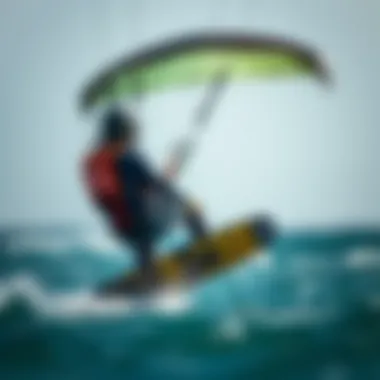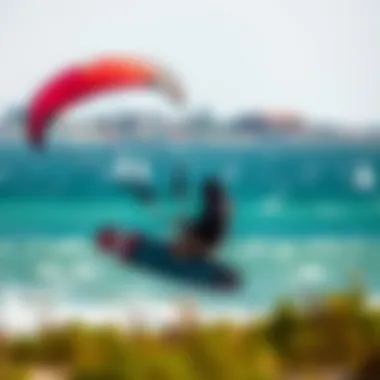Top Trainer Kites for Kiteboarding: Expert Reviews


Intro
When it comes to kiteboarding, the right trainer kite can play a significant role in determining your learning curve and overall enjoyment. Selecting the ideal kite is crucial not just for beginners, but even seasoned riders might benefit from understanding the nuances involved in trainer kite choices. With an abundance of kites on the market, knowing which one shines in terms of performance, usability, and safety becomes essential. This guide digs into the best trainer kites tailored for varied skill levels, exploring key features, designs, and materials that influence the riding experience.
In this article, we’ll take you through a comprehensive overview of what makes a trainer kite standout. We'll delve into reviews of top models, examine sizes and shapes, and highlight their usability for riders just getting their feet wet, or even those looking to refine their techniques. Throughout this discussion, an emphasis on safety, maintenance, and the overall advantages of using trainer kites will be presented. Whether you’re contemplating your first venture into kiteboarding or seeking to enhance your skills with the right equipment, the insights shared here aim to navigate your choices effectively.
Understanding Trainer Kites
When diving into the world of kiteboarding, it’s crucial to start with a solid grasp of trainer kites. These kites serve not only as an initiation tool but also as an essential element in the progression of one's skills in kiteboarding. Understanding the role of trainer kites can significantly impact a rider's learning experience, ensuring safety and facilitating quicker mastery of techniques.
Definition and Purpose
A trainer kite is a scaled-down version of the kites used for actual kiteboarding, designed specifically for beginners. Unlike traditional kites, which can be cumbersome and overwhelming for novices, trainer kites offer a manageable size that enables easier control and manipulation. By practicing with these kites, beginners can develop a solid foundation in kite handling, learn how to control the power of the wind, and become familiar with the nuances of steering without the added complexity of being on the water.
The purpose of a trainer kite goes beyond just practicing; it provides an invaluable introduction to the techniques and mechanics of kiteboarding. Beginners can safely learn how different wind conditions affect kite performance and build muscle memory while standing on solid ground. This practice lays a critical groundwork before they take the plunge into actual kiteboarding. The hands-on experience gained from maneuvering a trainer kite helps riders transition more smoothly into riding on the water.
Benefits of Using Trainer Kites
Employing a trainer kite comes with a multitude of benefits that significantly enhance the learning curve for new kiteboarders. Here are some notable advantages:
- Safety First: Trainer kites are typically smaller and less powerful than full-sized kites. This means there’s less risk involved when learning to control and steer them.
- Cost-Effectiveness: Investing in a trainer kite is often more budget-friendly compared to purchasing a full kiteboarding setup. It allows beginners to start practicing without making a huge financial commitment.
- Skill Development: Using a trainer kite cultivates important skills. Beginners learn how to manage different wind conditions and develop the ability to launch, land, and depower the kite successfully.
- Confidence Boost: Gaining proficiency with a trainer kite can significantly boost confidence. When learners master these basic skills, they are more ready to tackle the challenges of riding.
"Investing time in a trainer kite is worth its weight in gold for aspiring kiteboarders. It’s the first step towards mastering the art of riding in the waves."
- Versatility: Trainer kites can also be utilized in various settings, whether on the beach, at a park, or even in large open fields, making them a versatile choice for practice.
In summary, understanding and effectively utilizing trainer kites is foundational for anyone looking to excel in kiteboarding. With the right approach, these kites are more than just equipment; they are stepping stones towards becoming a skilled kiteboarder.
Key Features of Trainer Kites
When selecting a trainer kite for kiteboarding, it’s crucial to think about several key features. These features not only enhance the kite's performance but also contribute significantly to the learning curve and overall experience of the user. Understanding these elements can turn a daunting task like choosing the right kite into a more manageable endeavor. This section will discuss the various features, focusing on material durability, design aspects, and size considerations.
Material and Durability
Material choice plays a central role in the durability of trainer kites. Kites are often made from different fabric types such as ripstop nylon and polyester. Ripstop nylon is quite popular due to its resistance to tearing, making it an excellent choice for beginners who may crash their kites frequently. Additionally, it tends to be lighter, which is beneficial when flying in low wind conditions. On the other hand, heavier materials may withstand the elements better but can become cumbersome.
A kite that can endure wear and tear increases the satisfaction level of any kiters. If the material fails, it could lead to frustrating experiences on the water. Besides the fabric, the stitching quality is crucial; ensure that the seams are reinforced to handle the pressures of strong winds. More durable kites may come at a higher cost, but remember—investing in quality can save you in the long run, preventing recurrent replacements.
Design Aspects
Design is more than just appearance; it encompasses various functional elements that can significantly impact performance. Two notable design aspects include shape variations and color visibility.
Shape Variations
Shape variations in trainer kites can greatly alter flight characteristics. Kites are generally categorized into delta, bow, and flat types. Each shape offers different advantages depending on user needs.
- Delta kites are known for their stability and ease of use. They perform well in a variety of wind conditions, making them an excellent choice for beginners.
- Bow kites, with their arched shape, create a larger wind window, allowing riders to fly smoothly even in lighter winds.


Among the most beneficial features of shape variations is how they affect the responsiveness of the kite. For example, a delta shape can help new riders gain confidence with stable and predictable behavior in the air. However, they might not handle high winds as effectively as some other shapes, causing a rollercoaster ride for very energetic sessions.
Color and Visibility
Color and visibility are not merely aesthetic considerations; they play an important role in kite safety and performance. Bright colors are advantageous because they allow for easier visibility against the sky and sea. In crowded locations, this could mean the difference between a close call and an accident.
High-visibility kites also help an instructor monitor a beginner’s progress from a distance. Using uniquely high-contrast colors can lead to quicker identification of the kite's orientation and position, especially in complex environments where multiple kites are flying.
However, color choice can impact heat absorption. Darker colors may heat up quicker in sunlight, which, though minimal, can affect the overall handling and responsiveness. So, while selecting a visually appealing kite, balance appearance with practicality.
Size Considerations
Choosing the appropriate size of trainer kite is fundamental to its performance. Typically, kites are categorized based on their size measured in square meters. For beginners, smaller kites, around 1.5 to 3.0 square meters, are ideal. These are easier to control and less intimidating for someone just starting out.
Conversely, larger kites can harness more power but require more experience to manage correctly. When sizing, consider not only the rider's weight but also environmental conditions like wind speed. A heavy rider in strong winds might benefit from a larger kite, while a lighter rider may find themselves better with something smaller.
Ultimately, understanding these key features—material decisions, design nuances, and size dynamics—sets the foundation for confidently selecting a trainer kite that aligns with every individual’s learning journey. By making informed choices based on such crucial aspects, kiteboarding enthusiasts can enhance their skills effectively.
Evaluating the Best Trainer Kites
When it comes to kiteboarding, selecting the right trainer kite can make all the difference. This section dives into the significance of understanding various models available, as well as how they cater to different levels of skill and experience. Navigating through the myriad of options allows riders to choose equipment that best suits their needs, enhancing not just their enjoyment but also their safety and learning process. A well-chosen kite empowers beginners while also providing advanced riders with a tool that can refine their techniques.
Top Models Overview
Features Comparison
Analyzing the features of different trainer kites is pivotal for making an informed choice. Key characteristics such as material quality, size, and design all play a crucial role in determining the kite's performance. For instance, a kite constructed from ripstop nylon offers both durability and lightweight properties, which many users find beneficial.
Unique features such as dual-line control offer added maneuverability, allowing the user to practice various tricks and techniques efficiently. The clarity in comparing features leads to spotting which kite would be a popular pick, as those who prioritize ease of use lean towards models with straightforward setups and intuitive handling. Some might find certain features like adjustable bridle points advantageous, while others may feel overwhelmed by complexity. The comparison here helps clarify what suits each rider's preference and ability level, ensuring a better match in the long run.
User Reviews Summary
User reviews serve as a window into the real-world performance and satisfaction of the trainer kites. These insights are invaluable. They highlight the strengths and weaknesses perceived by fellow kiteboarders, providing potential buyers with a sense of what to expect. A common thread in positive reviews tends to center around ease of use, which is crucial, especially for those starting out. Some users may share that a particular model allows for smooth launches even in tricky wind conditions, enhancing their confidence while learning.
However, like any product, there are drawbacks highlighted in the reviews, such as difficulty in control during strong winds or issues with drag. Being aware of these unique features can guide prospective buyers towards making a choice that aligns with their riding style and environment, ensuring that they are not left in the lurch during their initial kiteboarding attempts.
Model Recommendations for Beginners
For those taking their first steps into kiteboarding, certain models stand out as particularly suited to novice riders. Looking deeper into what these kites offer is essential. Kites with a lower aspect ratio and larger surface area typically provide better stability and easier handling. Brands like Peter Lynn and HQ Kites have models that are specifically engineered for beginners, ensuring that new riders can build confidence without the fear of overpowering winds.
Advanced Options for Skilled Riders
Experienced kiteboarders will benefit from advanced models that offer greater precision and speed. Kites with higher aspect ratios allow for enhanced performance in challenging conditions and can be tailored for specific styles of riding, be it freestyle, wave riding, or even racing. Brands like Naish and Fanatic target more skilled riders with specialized features, enhancing the overall performance and experience of the ride. A knowledgeable choice here can take an adept rider's skills to the next level, allowing them to push their limits and explore new horizons in their kiteboarding journey.
Selecting the Right Trainer Kite
Choosing the right trainer kite is paramount in the journey of becoming a proficient kiteboarder. It’s not just about picking a colorful piece of fabric; it's about finding a tool that aligns with your specific level of skill, the conditions you'll be flying in, and your personal preferences. The right trainer kite can facilitate smoother learning experiences, enhance your confidence, and ultimately make or break your time on the water.


Identifying Your Skill Level
Your skill level plays a critical role in selecting a trainer kite. Beginners often need a kite that's more stable and forgiving, while seasoned riders might favor a model that offers quicker responsiveness and higher speeds. If you're new to kiteboarding, opting for a larger, slower kite can help you develop basic skills without being overwhelmed. It's akin to learning to ride a bike with training wheels—sooner or later, you'll want to swap them for something that pushes your limits.
Environmental Factors to Consider
When choosing a trainer kite, examining environmental factors is key. The kiteboarding experience can significantly vary based on conditions like wind and the type of water you'll be using.
Wind Conditions
Wind conditions are arguably one of the most crucial aspects to consider. Gentle to moderate winds, usually between 10-20 knots, are ideal for beginners. Such conditions allow for a stable flying experience without being too aggressive. High winds can lead to a kite that overpowers the flyer; this might cause undesired situations, such as losing control or having difficulty launching.
Key Characteristic of Wind Conditions: Predictability is essential here. Places with consistent winds, like lakes or coastlines, are particularly favorable. If you’re practicing in an area known for gusty winds, you'll want to select a kite designed to handle rapid changes in pressure. Ultimately, understanding the wind conditions allows you to pick a kite that complements your chosen learning environment.
Water Type
The type of water—saltwater or freshwater—also influences your choice of a trainer kite. Saltwater environments can be harsher on equipment due to corrosion, so using a kite crafted from resistant materials is important. Freshwater, on the other hand, tends to be gentler on gear but can pose its own challenges, like shifting currents.
Key Characteristic of Water Type: Visibility of the bottom can impact your learning curve. In lakes, for instance, shallow sections can provide immediate feedback if you’re learning to body drag. Picking a kite suited for your frequent water type can streamline your practice.
Personal Preferences and Goals
Last but not least, personal preferences play a major role in your decision. Some riders might prefer a specific color scheme or brand due to brand loyalty or aesthetic appeal. Others might prioritize ease of setup or the ability to perform tricks. Knowing your end goals in kiteboarding—whether it’s purely learning or advancing into complex maneuvers—guides you to a kite that fulfills those aspirations while also ensuring enjoyable rides.
"Choosing the right trainer kite is less about fancy features and more about understanding your needs as a rider."
Safety and Maintenance
In kiteboarding, the exhilaration of gliding across the water, propelled by a large, colorful kite, is matched only by the inherent risks involved in the sport. Understanding the importance of safety and maintenance is crucial for both enjoyment and longevity in kiteboarding. This section delves into why safety gear, proper kite maintenance, and emergency procedures are not just recommendations, but necessities for anyone looking to take up this thrilling activity.
Safety Gear Essentials
When it comes to kiteboarding, protecting yourself should always be a top priority. Essential safety gear includes:
- Personal Flotation Device (PFD): A good PFD can make a huge difference in an emergency. Look for one that is designed specifically for kiteboarding, providing both buoyancy and the freedom of movement needed for maneuvering.
- Helmets: Falling can lead to hits to the head, even at moderate speeds. A sturdy helmet can protect against unfortunate accidents.
- Impact Vest: This piece works alongside your PFD to cushion your body from hard landings. It can provide added warmth on chilly days.
- Leashes: Ensure you always have a reliable leash for your kite. This keeps the kite tethered to you, preventing it from being swept away in the wind.
Investing in high-quality gear is like putting on your seatbelt — you might never need it, but if you do, you'll be glad to have it on.
"Preparation not only minimizes the risks but enhances the overall experience of kiteboarding."
Kite Maintenance Tips
Keeping your trainer kite in good shape is key for both performance and safety. Here are tips to ensure your kite does not turn into a liability:
- Regular Inspections: After each session, check for any wear and patches on fabric or lines. Look for signs of fraying or damage caused by sand, salt, or UV rays.
- Proper Storage: Avoid leaving your kite in the sun for extended periods. Store it in a cool, dry place, and ensure it's free of moisture to prevent mildew.
- Cleaning Techniques: Rinse your kite with fresh water after using it in saltwater or sandy environments. This helps to prolong the life of the fabrics and prevents corrosion.
- Line Care: Keep the lines untangled and free from knots. Replace them if they show signs of wear and tear.
Maintenance is not merely a chore; it's part of respecting the equipment that lets you fly.


Emergency Procedures
Even with the best safety protocols in place, emergencies can happen. Understanding how to respond can make all the difference.
- Know Your Zone: Familiarize yourself with the area you’re kiteboarding in. Knowing where to go in case of trouble is essential. Have a plan for what to do if you end up in a strong current or adverse weather.
- Disconnect Safely: If you need to release your kite quickly, stay calm. Knowing how to safely disconnect the kite from your harness can enable a swift retreat.
- Signal for Help: If you find yourself in a pickle, waving your arms may signal to others that you need assistance. Make sure you know how to attract attention.
- Communicate with Buddy: Always kite with a partner when possible. Establish hand signals or communication protocols beforehand to alert each other of any danger.
Emergency preparedness is about having the knowledge to act rather than panic. Familiarizing yourself with these procedures can help you keep both you and your fellow kiteboarders safe during any outing.
The Learning Curve of Kiteboarding
Understanding the learning curve in kiteboarding is crucial for anyone stepping into this exhilarating sport. Kiteboarding isn’t just about catching the wind and gliding over the waves; it’s a gradual process where skill, safety, and confidence steadily merge. The journey can seem daunting for newcomers, but recognizing the various stages of progression can simplify this adventure.
Stages of Progression
Every kiteboarder goes through distinct stages on their path to becoming proficient. Here’s a closer look at these stages:
- Ground School
At this initial stage, learners familiarize themselves with their trainer kite, soaking up the essential safety practices and basic kite control techniques. This may include the following: - Water Introduction
Once grounded in theory, the next phase usually takes you to shallow water. Here, you will control the kite while standing or kneeling. This phase is key: - Body Dragging
In further learning, body dragging becomes essential. While tethered to your kite, you will be pulled through the water without the board. This helps you: - Getting Up on the Board
Finally, the highly anticipated moment arrives when you attempt to stand up on the board. This stage can be challenging but is often filled with excitement. It requires: - Refining Techniques and Tricks
Once you're up and riding, it's all about refining your skills. This involves:
- Understanding wind patterns
- Debunking common myths about kiteboarding
- Practicing basic maneuvers on the ground
- You'll learn to manage your balance in the water
- You begin to incorporate body movement into kite control
- There’s a focus on self-rescue techniques as well
- Gain confidence in water control
- Develop a feel for how different wind strengths affect your kite
- Work on your body positioning for when you add the board
- Timing the pull of the kite with your movements
- Maintaining balance as you navigate your first rides
- Embracing the inevitable falls, which are integral to mastering the sport
- Stacking more time on the board
- Experimenting with speed, jumps, and advanced maneuvers
- Embracing different conditions to challenge and hone your ability
Using a Trainer Kite Effectively
The trainer kite should never be underestimated; it is the bedrock for a strong start in kiteboarding. A few pointers can help you utilize your trainer kite to its utmost potential:
- Consistent Practice: Regularly flying your trainer kite will establish muscle memory and improve your control. Try to practice in different conditions to enrich your experience.
- Educate Yourself About the Gear: Know your trainer kite inside and out. Understanding each component—the lines, the control bar, and the kite itself—is paramount for effective use.
- Utilize Recognizable Landmarks: Keeping your bearings can change the game. Use natural markers to gauge distances before you start from the shore, giving you feedback on your flying techniques.
- Participate in Group Sessions: If possible, practice with others. This fosters a fun environment and insights from fellow learners can significantly enhance your kushion.
- Stay Patient and Positive: Mastery won't come overnight. It's all about building confidence step-by-step, learning, and adapting as you go along.
Remember, the journey of a thousand miles begins with a single step. Embrace the gradual learning process, and don't rush it. Each stage lays critical groundwork for a safe and thrilling kiteboarding experience.
Culmination
In wrapping up this extensive guide on trainer kites, it’s clear that understanding the intricacies of these essential tools is fundamental for anyone looking to excel in kiteboarding. The choice of a trainer kite isn’t just about picking a pretty color or the latest model on the market; it’s about aligning with your unique skills and aspirations. A suitable kite can significantly affect your learning experience, safety, and ultimately, your enjoyment of the sport.
Choosing a trainer kite that suits your specific needs aids in the onboarding process for beginners while maintaining performance aspects for advanced riders. Whether it's the materials used, the design, or size considerations, each element plays a pivotal role in enhancing your kiteboarding experience. By knowing what features to look out for, you can quickly hone in on what fits best.
Benefits of trainer kites should not be underestimated. They serve as a bridge between mere interest in kiteboarding and actual proficiency in the sport. These kites not only build air awareness but also help in mastering control—skills that will serve a kiteboarder for years to come. Moreover, the fun factor shouldn't be overlooked; the thrill of managing a trainer kite can keep motivations high during practice sessions.
Also, the emphasis on safety and maintenance that was discussed cannot be taken lightly. Regular inspections and understanding emergency procedures will ensure not only your safety but also the longevity of your equipment.
Ultimately, the journey with a trainer kite is about progress, patience, and passion. Each ascent and descent, every gust of wind, represents steps toward mastery in kiteboarding. By immersing yourself in the nuances of trainer kites, you're setting a solid foundation for an exciting sport that merges adventure with athleticism. As you set off into the wind, remember to embrace the learning process, savor each moment, and let the kite guide you toward new horizons.
Final Thoughts on Trainer Kites
Trainer kites play a crucial role in the journey of any kiteboarding enthusiast. They are, in many ways, the first step on a path filled with potential and excitement. Selecting the right trainer kite should align with both your current skill set and your ambitions for the future.
As you explore the vast opportunities kiteboarding offers, keep in mind that every successful ride begins long before you ever take to the water. Equip yourself with knowledge about trainer kites, and you'll find that the world of kiteboarding is truly at your fingertips.







